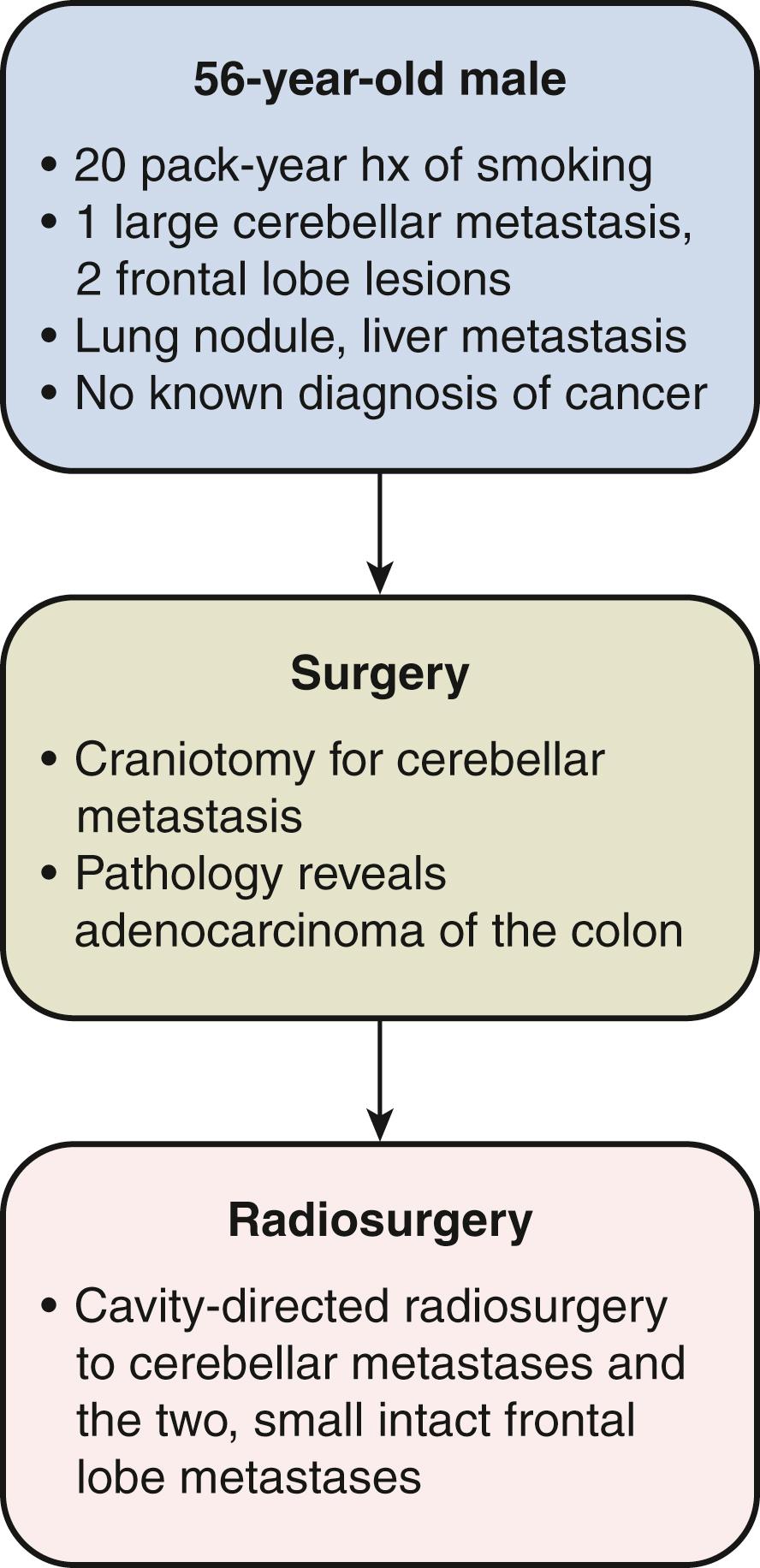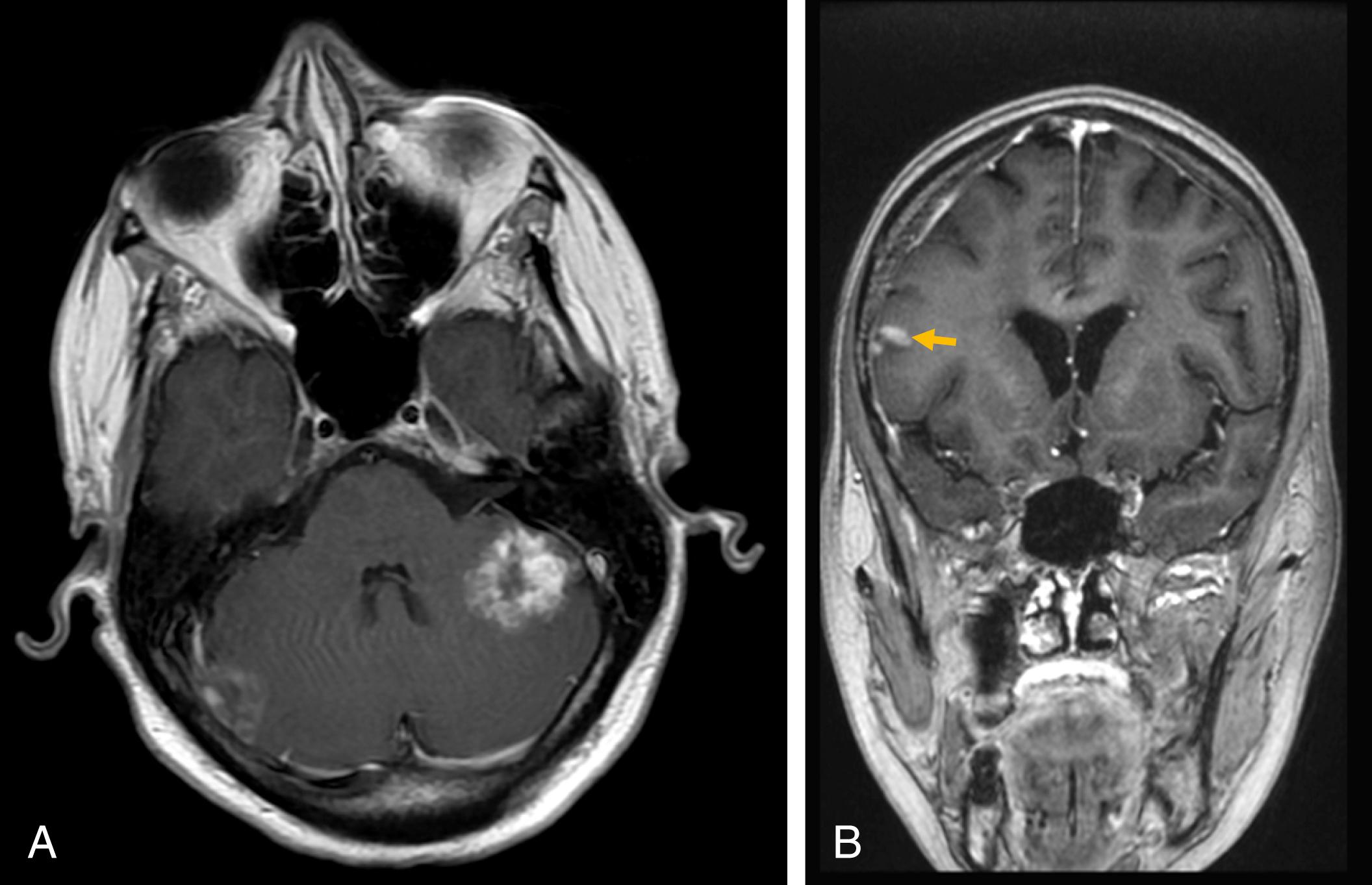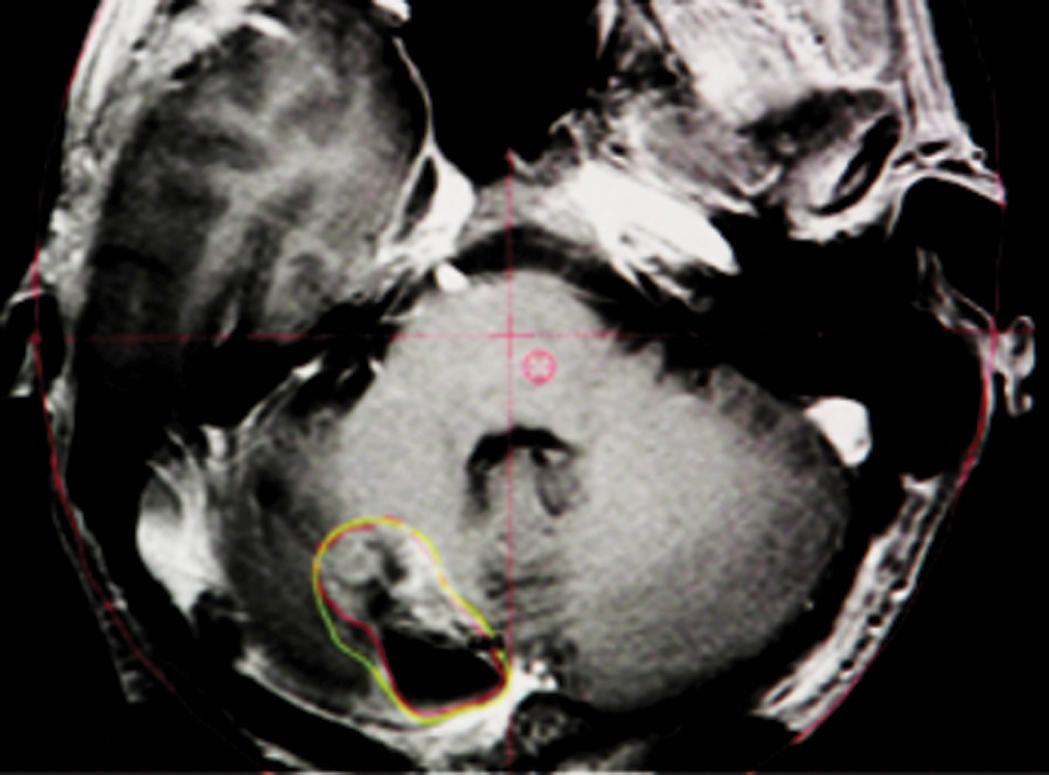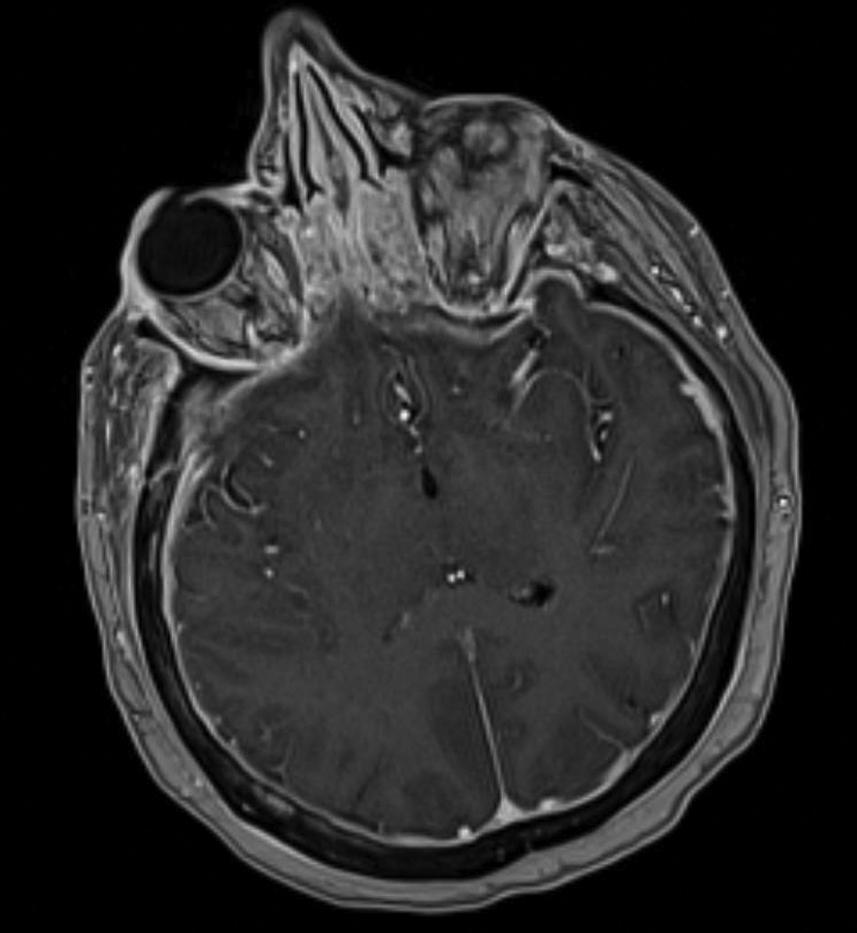Physical Address
304 North Cardinal St.
Dorchester Center, MA 02124
Brain metastases are a frequent occurrence in patients with solid malignancies. Up to 40% of patients with solid tumors will develop brain metastases at some point in their disease course, and 170,000 patients are diagnosed with brain metastases each year. The most common solid tumors that metastasize to the brain are lung, breast, melanoma, renal cell carcinoma, and gastrointestinal (GI) malignancies. The incidence of brain metastases appears to be rising, as better diagnostic methods have evolved (i.e., MRI) and, perhaps more important, systemic therapy has improved. These therapies have improved control of malignant disease outside of the central nervous system (CNS), and patients with metastatic disease are living longer. Because of longer life spans in patients with metastatic cancer, the length of time for patients to develop brain metastases is extended. Although many chemotherapeutic agents work well outside the CNS, they often fail to cross the blood-brain barrier, and many are unable to prevent tumor cells from seeding the brain parenchyma.
The life expectancy of patients with brain metastases is highly variable. The median survival is about 7.2 months, but ranges from 2.8 to 25 months. When considering appropriate management for brain metastasis, clinicians commonly consider histology, age, performance status, and extent of systemic disease (i.e., few sites of metastatic disease vs numerous sites of disease). Clinicians often use a tool called the Diagnosis-Specific Graded Prognostic Assessment (DS-GPA) to aid prognostication. The tool helps predict overall survival in patients with brain metastases. For instance, the estimated survival for a patient with melanoma, poor performance status, and four brain metastases is 3.5 months, whereas for a patient with breast cancer with two brain metastases and a favorable phenotype (estrogen and progesterone positive, HER2 negative), the median survival is 25 months.
MRI is the recommended imaging modality for routine staging particularly with cancers that have a high frequency of brain metastasis ( Table 14.1 ). In lung cancer, due to the high frequency of brain metastases, an MRI is accepted as a standard component of screening for all stages of disease. Additionally, an MRI is reasonable to obtain in an aggressive locally advanced melanoma with nodal disease. In patients with neurologic symptoms such as headaches, seizures, ataxia, or focal neurologic deficits, an MRI is indicated for patients with breast cancer, renal cell carcinoma, or GI malignancies. It is also useful to know that squamous cell carcinoma of the head and neck, such as HPV-related oropharyngeal cancer, nasopharyngeal cancer, laryngeal cancer, or tongue cancer, rarely metastasize to the brain. Direct perineural invasion via cranial nerve foramen may be seen in these patients and result in intracranial spread of malignancy as opposed to parenchymal brain metastasis. Prostate and pancreatic cancer rarely metastasize to the brain.
| MRI recommended as staging for initial diagnosis without symptoms | MRI recommended for patients with focal neurologic symptoms | Rarely metastasize to brain |
|---|---|---|
| Small-cell lung cancer | Breast cancer | Squamous cell carcinoma of the head and neck |
| Non–small-cell lung cancer | Renal cell carcinoma | Pancreatic cancer |
| Advanced melanoma (Stage IIIC or higher) | Colon, rectal, and esophageal cancer | Prostate cancer |
In the following cases, we will describe common clinical scenarios and available treatment options for patients with brain metastasis.
Case. A 56-year-old male with a 20 pack-year history of smoking presents to the emergency room with 3 weeks of headache and confusion ( Fig. 14.1 ). There is no history of seizures and no known cancer diagnosis. The patient’s vital signs are stable and an MRI demonstrates a large, 2.3 × 2.5 cm 2 enhancing lesion in the left cerebellum, as well as lesions in the right cerebellum and right frontal lobe concerning for metastases ( Fig. 14.2 ). Neurologic examination is significant for dysdiadochokinesia and a wide-based gait. Upon admission, a CT scan of the chest abdomen pelvis reveals a 1.5-cm nodule in the right upper lobe of the lung and a 3-cm enhancing mass in the right lobe of the liver.


Craniotomy is performed and final pathology reveals adenocarcinoma of the colon. The patient is discharged and returns 3 weeks later for adjuvant radiation therapy to the cavity as an outpatient. An MRI, obtained for treatment-planning purposes, shows a resected tumor cavity as well as slight interval enlargement of the two previously identified frontal lobe metastases.
The patient is treated with stereotactic radiosurgery (SRS) to the cavity, as well as to the two small brain metastases in one session lasting about an hour and a half. The following week, he begins chemotherapy for colon cancer.
Teaching Points: Role of Craniotomy in Management of Brain Metastases. This case highlights the role of surgical resection and postoperative cavity-directed radiotherapy in brain metastasis patients.
Surgical resection is utilized in several clinical scenarios including metastases that are: (1) large size (≥3 cm), (2) in patients without a known cancer diagnosis, or (3) for selected cases of local recurrence of brain metastasis at a site of prior radiation therapy ( Table 14.2 ). In the case of this patient, he presented with no known history of malignancy and several indeterminate findings on CT scan. The primary etiology of the lesion was not easily identifiable on imaging, and tissue diagnosis was needed before appropriate chemotherapy could be selected. If the patient is symptomatic, it is reasonable to start steroids (4 mg dexamethasone every 6 or 12 hours) prior to resection to help reduce mass effect and clinically significant vasogenic edema. Histologic diagnosis obtained from tumor tissue can be particularly useful to identify unsuspected or unknown primary tumors. In a seminal series by Patchell et al., 11% of the craniotomies performed for presumed brain metastases actually revealed primary brain tumors or abscesses. Thus, pathologic confirmation of malignancy is critical in patients without a known cancer diagnosis.
| Craniotomy for Brain Metastases | |
|---|---|
| Indications | Contraindications |
| No known cancer diagnosis | Eloquent area location (language centers, brainstem, occipital lobe, optic apparatus, motor cortex) |
| Large, symptomatic lesion with mass effect ≥3 cm |
Patient health declining precipitously, unrelated to brain mass |
| Recurrent brain metastasis previously treated with radiosurgery | Surgery would delay urgent chemotherapy |
A key concept in neuro-oncologic care is to preserve quality of life, independence, and neurologic function. In patients who are at risk of neurologic death from mass effect of a brain metastasis, surgical resection with tumor removal may rapidly alleviate symptoms. Conversely, surgery is often avoided in patients who are at risk of permanent neurologic deterioration after surgery. If the metastasis is close to an “eloquent area” of the brain, which includes the motor cortex, optic structures, occipital lobes, brainstem, or Wernicke’s or Broca’s areas, surgery is generally avoided. Radiation therapy can treat larger lesions effectively; however, these patients are at higher risk of morbidity due to acute brain swelling. A functional MRI or diffusion tensor weighted imaging to visualize neuronal tracks may be useful to delineate neuronal fibers and reduce damage to normal anatomy.
Patients who undergo a craniotomy for brain metastases, particularly in the cerebellum, are at a higher risk of developing leptomeningeal dissemination of cancer cells. The rate of leptomeningeal dissemination is approximately 20–30% in patients who undergo craniotomy, whereas it is less common in patients who are treated with SRS alone without craniotomy. Patients with leptomeningeal disease may present with progressive cranial nerve deficits, severe headaches, hydrocephalus, confusion, and altered mental status. A representative radiographic image of leptomeningeal disease is demonstrated in Fig. 14.5 . Lumbar puncture can confirm leptomeningeal disease, but a negative result from lumbar puncture does not exclude this etiology (see Chapter 15 , Cases 15.1 and 15.2). The prognosis of patients with leptomeningeal disease is poor, measured in weeks to months. There is no accepted standard treatment for leptomeningeal disease; however, whole brain radiation therapy (WBRT), SRS, intrathecal chemotherapy, high-dose methotrexate (for selected cancer histologies), or best supportive care are reasonable options based on patient and clinician preference.

Following surgery alone for brain metastasis, up to 50% of tumors will recur within the resection cavity without additional treatment. Cavity-directed SRS after craniotomy reduces the rate of recurrence to approximately 10–20%. Radiotherapy kills microscopic cancer cells left behind after surgery, which likely seed the tumor bed. SRS also provides an opportunity to treat other metastases during the same session of radiation therapy. In the case presented above, the two remaining metastases were managed during the same SRS delivery.
SRS involves several steps for treatment delivery and can be delivered with a Gamma Knife (Elekta, Stockholm, Sweden) or a specialized linear accelerator (see Chapter 3 , Case 3.2 for further discussion of principles of stereotactic radiosurgery). Both emit high-energy photons, which kill cells via damage to DNA. The key differences between the two machines are that Gamma Knife uses radioactive Cobalt-60 as a photon source and treats only intracranial targets. A linear accelerator does not have radioactive material stored inside, but rather accelerates electrons, which collide with a block of tungsten. This collision of electrons and tungsten emits photons, which are directed toward the patient. Linear accelerators are more versatile than the Gamma Knife and can treat intracranial targets as well as other cancers throughout the body (i.e., gliomas, head and neck cancer, prostate cancer, breast cancer, etc.).
Radiosurgery treatment planning . There are several steps involved with radiation therapy delivery ( Fig. 14.3 ). First, the head must be immobilized so the patient cannot move during treatment. This can be accomplished with a stereotactic halo placed by neurosurgery (e.g., with Gamma Knife) or with the use of a tight-fitting mask (e.g., with linear accelerator). Then, the patient undergoes an MRI with contrast. The neurosurgeon and radiation oncologist outline the edges of the tumor on the MRI, using the T1-weighted contrast-enhanced sequences for target delineation. In the case of the stereotactic halo, this is placed during the treatment planning MRI, and clinicians can use the exact geometric coordinates to create a plan, with 0.1 mm accuracy. In the patient case presented above, the two small asymptomatic lesions were also treated and would be outlined at this point in the treatment-planning process. The radiation oncologist and neurosurgeon design a plan to effectively treat the resection bed (e.g., cavity-direct therapy), which harbors microscopic tumor cells, while minimizing the risk to normal brain parenchyma. After the radiation plan is created, the treatment is automated and delivered. In the figure ( Fig. 14.4 ), a right cerebellar cavity has been outlined and a treatment plan created to effectively treat microscopic disease. All of the enhancing cavity bed is outlined and targeted.


Radiosurgery treatment delivery . Treatment typically lasts 30 minutes to 2–3 hours, depending on the complexity of the plan. The patient is awake, without general anesthesia and does not have to be NPO prior to the procedure. The patient does not feel the radiation, and many fall asleep during treatment. After the radiation is delivered, the stereotactic halo is removed and the patient is discharged home. For very large metastases, a short 2–3-day course of corticosteroids may be prescribed to help prevent acute swelling from radiation damage to the brain parenchyma.
Become a Clinical Tree membership for Full access and enjoy Unlimited articles
If you are a member. Log in here